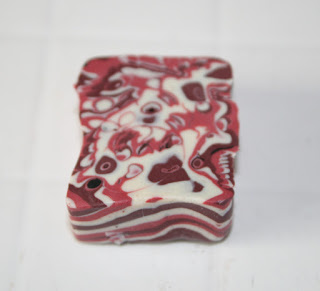In polymer clay there are many styles of this technique varying from the materials used such as translucent clay, foils and paints and also variations on how the markings and imprints can be made onto the clay such as stamping, impressing/indenting and slicing.
The technique I have used today is a simply impressing technique and is simple technique for any beginners looking to explore more with polymer clay.
Once your colour palette has been chosen the clay is prepared and stacked in alternating colours, cut in half and stacked again creating a clay block.
The clay is then impressed using tools and or simply objects you may have lying around the house ,they need to be quite deep to cut into the clay block, but not all the way, this is where you get to experiment and play with your patterns and have fun.
.JPG) |
| Mokume Gane Polymer Clay - My impressed clay block |
Once the block is complete, you can start taking thin slices off the top of your block with your blade and as you work your way down the patterns become quite pretty and intriguing.
.JPG) |
| Mokume Gane Polymer Clay - Slices are taken from my clay block showing a beautiful pattern |
 |
| Mokume Gane Polymer Clay - the colours and patterns will change |
I used the slices from my cane and placed them onto a background sheet, once placed I carefully smoothed them down with a roller and also run the sheet through the pasta machine a couple of times to spread my print which is now ready to work with.
.JPG) |
| Mokume Gane Polymer Clay - Slices covered over a background sheet |
Here are some pendant shapes I have created using my mokume gane sheet, waiting to be cooked.
.JPG) |
| Mokume Gane Polymer Clay - my pre-cook pendant shapes |
Here is an example of a pendant created a few years ago, the clay stacked was created using translucent and silver foils within, to create this wonderful effect.
 | ||
| Mokume Gane Polymer Clay - A pendant created using mokune game |
This post is part of Handmade Monday with Handmade Harbour

Amazing effect. Love how the colours seem to ripple through the clay.
ReplyDeleteWow, that's brilliant. Thanks for showing us how it's all done. The patterns are lovely.
ReplyDeleteWhat an interesting technique. The results are really beautiful.
ReplyDeletei love this technique! it looks like great fun to experiment with it and the results are fantastic! x
ReplyDeleteThis looks like a wonderful and creative medium to work with. Thank you for the tutorial.
ReplyDeleteThat's really interesting and looks like a lot of fun too. Love the patterns - endless possibilities! x
ReplyDeleteI've seen finished Mokume Gane and wondered how it was achieved. This is a great tutorial- really clear explanations, thank you.
ReplyDeleteWow, such a lovely way of getting a pattern into the clay.
ReplyDeleteReally enjoyed reading about the techniques - great effect!
ReplyDeleteWow, interesting technique with fab results
ReplyDeleteWow. Really unusual (I've never heard of it) but so beautiful. I love it!
ReplyDeleteThank you everyone :)
ReplyDeleteI love the way you get different patterns as you go down. I love the final effect.
ReplyDelete